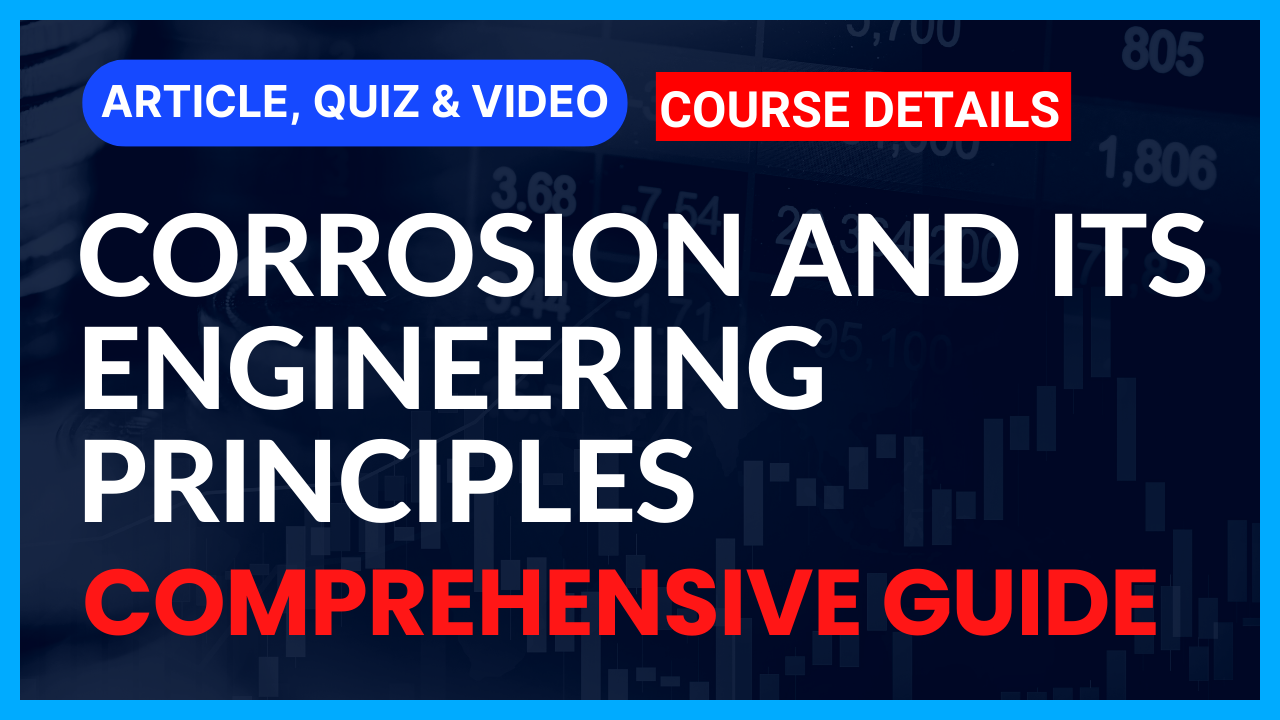Introduction
Corrosion, a natural process, instigates the transformation of refined metals into more chemically stable oxides. This metamorphosis occurs through chemical or electrochemical reactions that transpire when these metals interact with their surrounding environment. As metals succumb to corrosion, they undergo gradual deterioration, impacting their structural integrity and overall functionality.
Corrosion Engineering, a specialized field, is dedicated to combating the effects of corrosion. This discipline aims to control and prevent the degradation of materials caused by corrosion, thus extending their lifespan and utility. By leveraging a combination of scientific knowledge, engineering principles, and innovative strategies, corrosion engineers develop methods to mitigate the damaging effects of corrosion on a variety of materials and structures.
In the following sections, we will delve deeper into the intricacies of corrosion and its management. We will explore fundamental concepts such as corrosion allowance and corrosion rate, investigating how they contribute to the overall understanding of material deterioration. Moreover, we will examine the relationship between corrosion rate and corrosion allowance, elucidating how they interplay to ensure effective protection against the ravages of corrosion. Through a comprehensive exploration of Faraday’s Laws, electrochemical corrosion, corrosion current, corrosion density, and other relevant parameters, we will equip ourselves with the tools needed to combat corrosion effectively.
In essence, this article serves as a comprehensive guide to understanding the phenomenon of corrosion, the principles underlying its progression, and the strategies deployed by corrosion engineers to safeguard valuable materials and assets.
Table of Contents
Don’t miss the course on Corrosion allowances & Corrosion Rate: 12 Modules
Enrollment Link
1. Corrosion Allowance: Protecting Against Deterioration
Corrosion Allowance Definition Corrosion allowance refers to an additional layer of material incorporated into the design thickness of a component to account for the gradual loss of material due to corrosion over its operational lifespan. This extra material acts as a buffer, ensuring that the component remains structurally sound even as corrosion gradually erodes its surface. The corrosion allowance is a proactive measure, anticipating the inevitable effects of corrosion and safeguarding the integrity of the component.
Incorporating Corrosion Allowance In engineering design, the corrosion allowance is typically added to the minimum required thickness of a component. This adjusted thickness takes into consideration the expected rate of corrosion based on the specific environment and operational conditions. By factoring in this allowance, engineers account for the material loss that would occur due to corrosion, without compromising the component’s functional capabilities.
Utilizing Corrosion-Resistant Cladding In scenarios where the corrosive environment is particularly aggressive, engineers may opt for an alternative approach to protect components from corrosion. Corrosion-resistant cladding involves applying a layer of a corrosion-resistant material onto the surface of the component. This cladding acts as a barrier, shielding the underlying material from direct contact with the corrosive environment. By doing so, engineers can prolong the component’s lifespan and reduce the need for frequent maintenance or replacement.
2. Corrosion Rate: Measuring Deterioration Speed
Defining Corrosion Rate Corrosion rate is a crucial metric that quantifies the speed at which a metal deteriorates when exposed to a specific environment. It is typically measured in terms of the amount of material lost per unit time, commonly expressed as millimeters per year. Corrosion rate serves as an indicator of the severity of the corrosive environment and the susceptibility of the metal to corrosion.
Factors Influencing Corrosion Rate The rate at which corrosion occurs depends on a multitude of factors. Environmental conditions, such as temperature, humidity, acidity, and the presence of corrosive agents, play a significant role in influencing the corrosion rate. Additionally, the type and condition of the metal under consideration contribute to the overall rate of deterioration. Metals with inherent corrosion resistance or protective oxide layers may exhibit slower corrosion rates compared to those that lack such protective features.
Don’t miss the course on Corrosion allowances & Corrosion Rate: 12 Modules
Enrollment Link
3. Relationship Between Corrosion Rate & Corrosion Allowance
Balancing Deterioration and Protection The relationship between corrosion rate and corrosion allowance is pivotal in engineering design. Engineers must strike a balance between the anticipated rate of corrosion and the protection provided by the corrosion allowance. By carefully calculating and incorporating the appropriate corrosion allowance, engineers ensure that the component’s structural integrity remains intact throughout its operational life, even as corrosion takes its toll.
Optimizing Design Thickness Determining the ideal corrosion allowance involves considering the specific operational environment, the expected corrosion rate, and the intended service life of the component. The corrosion allowance is added to the minimum required thickness to create a design thickness that can withstand the expected level of corrosion without compromising the component’s functionality.
In the subsequent sections of this article, we will delve deeper into the fundamental principles that underpin corrosion engineering. We will explore Faraday’s Laws, electrochemical corrosion processes, corrosion current, corrosion density, and other essential parameters that guide the development of effective corrosion prevention strategies. Through this comprehensive exploration, we will equip ourselves with the knowledge needed to mitigate the destructive effects of corrosion and ensure the durability of materials and structures.
4. Faraday’s Laws: Fundamental Principles of Electrochemical Corrosion
Introduction to Faraday’s Laws Faraday’s Laws of Electrolysis form the foundation for understanding electrochemical processes, including corrosion. These laws were established by Michael Faraday and describe the quantitative relationships between the amount of substance involved in a chemical reaction and the electric current flowing through an electrolyte.
Electrochemical Reactions in Corrosion In the context of corrosion, Faraday’s Laws help elucidate the electrochemical reactions occurring at the metal’s surface. These reactions involve anodic dissolution, where metal atoms release electrons and become ions, and cathodic reduction, where ions accept electrons and undergo transformation. The combination of these reactions leads to the overall corrosion process.
Quantifying Material Loss Through Electrochemical Processes Faraday’s Laws provide a means to calculate the amount of metal that corrodes during a given electrochemical reaction. By quantifying the electric current passing through the reaction and the electrochemical equivalent of the metal, engineers can estimate the mass of metal lost due to corrosion. This fundamental understanding enables engineers to predict the extent of material degradation and design effective corrosion mitigation strategies.
5. Electrochemical Corrosion: Unveiling the Process
Electrochemical Cells in Corrosion Corrosion occurs within electrochemical cells, where oxidation and reduction reactions take place simultaneously. These cells consist of an anode, where oxidation occurs, and a cathode, where reduction occurs. Electrolytes, typically in the form of liquids or moist environments, facilitate the movement of ions and electrons between the anode and cathode.
Anode and Cathode Reactions At the anode, metal atoms release electrons, generating metal ions and electrons that flow through the circuit. At the cathode, reduction reactions take place, where ions from the electrolyte combine with electrons to form compounds. The flow of electrons from the anode to the cathode drives the electrochemical corrosion process.
Understanding the Role of Ions in Deterioration Ions present in the electrolyte play a critical role in corrosion. They facilitate the movement of charge and mass within the electrochemical cell. The rate at which ions move and react at the cathode and anode influences the overall corrosion rate. Understanding this ion movement is key to predicting and managing corrosion effectively.
In the upcoming sections, we will delve into the specifics of corrosion rate, corrosion allowance, and their interplay. We will explore how these concepts are interconnected and how they inform corrosion engineering decisions. Additionally, we will delve deeper into corrosion density, Tafel plots, and various electrochemical parameters, equipping ourselves with the knowledge needed to quantify and combat corrosion effectively.
Don’t miss the course on Corrosion allowances & Corrosion Rate: 12 Modules
Enrollment Link
6. Corrosion Current: Current Flow in Electrochemical Cells
Explanation of Corrosion Current Corrosion current is the flow of electric current within an electrochemical cell during the corrosion process. It represents the rate at which metal is oxidized at the anode and the corresponding reduction reactions occurring at the cathode. Corrosion current is a critical parameter as it directly influences the rate of material deterioration.
Correlation Between Corrosion Current and Corrosion Rate Corrosion current is closely linked to the corrosion rate. The higher the corrosion current, the faster the corrosion process occurs. By measuring and monitoring the corrosion current, engineers can gain insights into the speed at which the metal is deteriorating in a specific environment.
Measuring and Controlling Corrosion Current Corrosion current can be measured using various electrochemical techniques. Techniques like potentiostatic and galvanostatic measurements provide valuable information about the electrochemical reactions taking place during corrosion. By understanding and controlling the factors influencing corrosion current, engineers can devise strategies to minimize material degradation.
7. Corrosion Density: Understanding the Distribution of Corrosion
Defining Corrosion Density Corrosion density refers to the spatial distribution of corrosion across the surface of a material. It provides insights into areas of higher and lower corrosion rates, helping engineers identify regions that are more susceptible to deterioration. Corrosion density maps assist in targeting protective measures and assessing the effectiveness of corrosion prevention strategies.
Mapping the Distribution of Corrosion Various factors contribute to uneven corrosion density across a material’s surface. Variations in exposure to corrosive agents, temperature gradients, and the presence of impurities can lead to localized corrosion. Mapping corrosion density aids in understanding these variations and enables engineers to tailor mitigation strategies accordingly.
Implications for Material Integrity Understanding corrosion density is crucial for ensuring the structural integrity of materials. Concentrated corrosion in specific areas can weaken the material, potentially leading to failures or reduced performance. By addressing areas of high corrosion density through appropriate design modifications or protective coatings, engineers can extend the material’s lifespan and reliability.
As we progress through this exploration of corrosion and its engineering principles, we will delve deeper into concepts such as the equivalent weight for pure elements and alloys, formulas for calculating corrosion rate based on Faraday’s Laws, and the utilization of Tafel plots for corrosion current determination. These insights will empower us to perform accurate calculations and make informed decisions when tackling corrosion-related challenges.
8. Equivalent Weight for Pure Elements & Alloys
Significance of Equivalent Weight in Corrosion Calculations Equivalent weight, also known as equivalent mass, is a crucial parameter in corrosion calculations. It represents the mass of a substance that can either donate or accept one mole of electrons during an electrochemical reaction. Equivalent weight simplifies the application of Faraday’s Laws and aids in quantifying the amount of material undergoing corrosion.
Calculation Differences for Pure Elements and Alloys For pure elements, the equivalent weight is directly proportional to the atomic weight of the element. However, for alloys composed of multiple elements, the calculation becomes more complex. The equivalent weight for alloys takes into account the individual atomic weights of the alloying elements and their respective valencies.
Don’t miss the course on Corrosion allowances & Corrosion Rate: 12 Modules
Enrollment Link
9. Formula for Corrosion Rate from Faraday’s Laws
Deriving the Corrosion Rate Formula Faraday’s Laws provide a basis for calculating corrosion rate using the concept of equivalent weight. The formula involves the multiplication of the corrosion current by the equivalent weight and constants related to the number of electrons involved in the reaction. This formula quantifies the rate at which material is lost due to corrosion.
10. Tafel Plots: Analyzing Corrosion Current
Introduction to Tafel Plots Tafel plots are graphical representations used to analyze the behavior of corrosion current in electrochemical reactions. These plots provide insights into the kinetic parameters of corrosion processes, such as the corrosion potential and the rate of electrochemical reactions.
Extracting Corrosion Current Information From Tafel plots, engineers can deduce crucial information about the corrosion current, including the Tafel slopes, which indicate the rate of anodic and cathodic reactions. This information helps in understanding the dominant electrochemical reactions and the associated corrosion behavior.
Applications in Corrosion Rate Determination Tafel plots are used to estimate corrosion current and corrosion rate under specific conditions. By extrapolating Tafel slopes, engineers can gain insights into the corrosion behavior and design effective corrosion mitigation strategies.
In the subsequent sections, we will delve into practical examples, calculations, and case studies that highlight the application of these principles. By navigating through these real-world scenarios, we will strengthen our grasp of corrosion engineering and develop the skills needed to effectively manage and prevent material degradation caused by corrosion.
11. Examples of Electrochemical Parameters for Few Elements
Case Studies of Electrochemical Parameters To gain a deeper understanding of how different metals behave in corrosive environments, let’s explore case studies of electrochemical parameters for select elements. By examining the electrochemical behavior of various metals, we can identify trends, variations, and factors that influence corrosion rates and behaviors.
Analyzing Different Metals’ Behavior Through these case studies, we can observe how metals like iron, aluminum, and copper respond to corrosion-inducing conditions. Factors such as the metal’s position in the galvanic series, its passivation behavior, and the presence of protective layers all play a role in shaping its corrosion characteristics.
12. Actual Calculations for Pure Elements & Alloys
Corrosion Current Calculations We will delve into the practical aspect of corrosion calculations, starting with determining corrosion current. By utilizing the corrosion current formula derived from Faraday’s Laws, we can quantitatively assess the rate of corrosion for both pure elements and alloys. This step-by-step calculation process will provide a clear roadmap for evaluating the corrosion behavior of different materials.
Corrosion Density and Equivalent Weight In addition to corrosion current calculations, we will explore how to calculate corrosion density and equivalent weight for both pure elements and alloys. These calculations offer insights into the distribution of corrosion across surfaces and aid in determining the amount of material lost due to corrosion.
Corrosion Rate Determination Drawing on the principles of Faraday’s Laws and the knowledge of corrosion current, corrosion density, and equivalent weight, we will derive formulas to calculate corrosion rate. By understanding the mathematical relationships and performing these calculations, we can accurately gauge the rate of material degradation caused by corrosion.
As we conclude this comprehensive exploration of corrosion and its engineering principles, we will have equipped ourselves with the skills, knowledge, and tools needed to tackle corrosion-related challenges. By mastering concepts like corrosion allowance, corrosion rate, Faraday’s Laws, electrochemical parameters, and practical calculations, we empower ourselves to be effective corrosion engineers, safeguarding valuable materials and structures from the detrimental effects of corrosion.
Don’t miss the course on Corrosion allowances & Corrosion Rate: 12 Modules
Enrollment Link
Conclusion: Safeguarding Materials Through Corrosion Engineering
Preserving Materials with Corrosion Engineering Corrosion, an inevitable natural process, poses a significant threat to the integrity and longevity of materials. Through the field of corrosion engineering, we gain the knowledge and tools to combat this destructive force. By understanding concepts such as corrosion allowance and corrosion rate, we lay the foundation for effective corrosion prevention strategies.
Balancing Deterioration and Protection Corrosion allowance strikes a delicate balance between anticipated material deterioration and proactive protection. It ensures that components remain structurally sound despite gradual corrosion-related material loss. This additional material guards against the potential risks of corrosion, enhancing the durability of materials and structures.
Quantifying Deterioration with Corrosion Rate Corrosion rate serves as a crucial metric, providing insight into the speed at which materials degrade in corrosive environments. By considering factors such as environmental conditions, metal type, and corrosion resistance, engineers can gauge the expected corrosion rate and tailor their prevention strategies accordingly.
The Role of Electrochemical Principles Fundamental principles like Faraday’s Laws and electrochemical reactions guide our understanding of corrosion processes. Electrochemical cells, anode and cathode reactions, and corrosion currents elucidate the mechanisms behind material deterioration. Tafel plots and electrochemical parameters offer tools for analyzing corrosion behavior and predicting corrosion rates.
Empowering Corrosion Engineers Armed with this comprehensive knowledge, corrosion engineers can make informed decisions about material selection, design considerations, and mitigation strategies. By applying the principles of corrosion allowance, corrosion rate calculation, and electrochemical analysis, engineers play a vital role in extending the lifespan of materials and minimizing the economic and safety implications of corrosion-related failures.
In a world where materials interact with their environment, corrosion engineering remains essential. As we continue to advance technologically, the understanding of corrosion and its management remains crucial to the durability, reliability, and safety of our infrastructure, equipment, and assets.
Table comparing the key concepts of corrosion allowance and corrosion rate:
| Concept | Corrosion Allowance | Corrosion Rate |
|---|---|---|
| Definition | Additional material added to design thickness to account for gradual corrosion | Speed at which a metal deteriorates due to corrosion in a specific environment |
| Purpose | Ensures structural integrity over operational life by accommodating material loss | Quantifies the extent of material degradation over time |
| Calculation | Added to minimum required thickness for components | Measured in millimeters per year (mm/year) or other appropriate units |
| Factors Considered | Environmental conditions, metal type, operational lifespan | Temperature, humidity, acidity, corrosive agents, metal type, condition |
| Relationship | Balances anticipated corrosion with proactive protection | Directly influences corrosion rate; higher corrosion rate means faster degradation |
| Measurement | Added to design considerations | Requires corrosion monitoring techniques (e.g., electrochemical methods) |
| Applications | Engineering design to account for expected material loss | Guides material selection, maintenance schedules, and corrosion mitigation strategies |
| Protection Strategies | Offers extra material buffer against corrosion | Informs protective measures and maintenance intervals |
| Outcome | Extends component lifespan and reduces maintenance needs | Guides decisions to prevent material failure and assess safety risks |
Please note that this table provides a general comparison between corrosion allowance and corrosion rate. The specifics may vary depending on the context and the materials involved.
Don’t miss the course on Corrosion allowances & Corrosion Rate: 12 Modules
Enrollment Link
FAQs
Frequently asked questions (FAQs) related to corrosion and its engineering principles:
1. What is corrosion, and why is it a concern in various industries?
- Corrosion is the gradual deterioration of materials, especially metals, due to chemical or electrochemical reactions with their environment. It poses a significant concern in industries like manufacturing, construction, infrastructure, and transportation, as it can lead to material failure, safety hazards, and increased maintenance costs.
2. How does corrosion allowance contribute to material protection?
- Corrosion allowance involves adding extra material to the design thickness of components. This added material acts as a buffer against the gradual loss of material due to corrosion. It ensures that components maintain their structural integrity throughout their operational life, even as corrosion takes place.
3. What factors influence the corrosion rate of metals?
- Corrosion rate depends on environmental factors such as temperature, humidity, and the presence of corrosive agents like acids or salts. The type and condition of the metal also play a role, as some metals naturally form protective oxide layers that slow down corrosion.
4. How do Faraday’s Laws relate to corrosion engineering?
- Faraday’s Laws of Electrolysis are fundamental principles that govern electrochemical reactions, including those involved in corrosion. These laws help engineers understand how metals corrode by quantifying the amount of material lost due to oxidation and reduction reactions.
5. What role does electrochemical corrosion play in material deterioration?
- Electrochemical corrosion involves reactions at anodic and cathodic sites on a metal’s surface. The metal releases electrons (anode) and ions combine with electrons (cathode), leading to corrosion. Understanding these reactions helps engineers predict corrosion rates, develop protective measures, and select appropriate materials.
Recommended courses (Published on EPCLand)
- Basics of Piping Engineering
- Piping Layout Engineering
- Piping Material Engineering
- Piping Stress Analysis
- Complete Course on Piping Engineering
- Material Requisitions
- Piping Material Specifications
- Valve Material Specifications
Don’t miss the published articles on following:
Related Video
Attempt Quiz
Question 1:
What is corrosion?
Explanation: Corrosion is the process of metal deterioration caused by chemical or electrochemical reactions with its surrounding environment.
Question 2:
Which type of corrosion occurs when two dissimilar metals are in electrical contact and exposed to an electrolyte?
Explanation: Galvanic corrosion, also known as bimetallic corrosion, occurs when two dissimilar metals are in electrical contact and exposed to an electrolyte, leading to accelerated corrosion of one of the metals.
Question 3:
What is the primary cause of crevice corrosion?
Explanation: Crevice corrosion occurs due to the presence of trapped corrosive fluids in small gaps or crevices, where oxygen levels may be lower and chemical reactions are concentrated.
Question 4:
What is the primary method to prevent corrosion in metals?
Explanation: Applying a protective coating, such as paint or corrosion-resistant materials, is a primary method to prevent corrosion in metals by creating a barrier between the metal and its environment.
Question 5:
What is the term for the corrosion that occurs under a layer of rust or other corrosion products?
Explanation: Underfilm corrosion refers to the corrosion that occurs beneath a layer of rust or other corrosion products on the surface of a metal, leading to localized deterioration.



